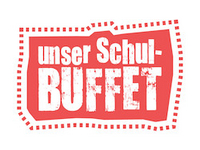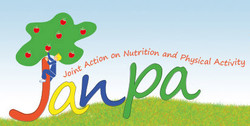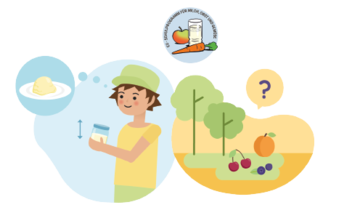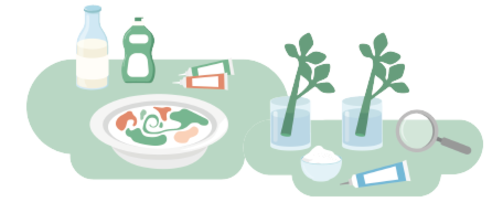Health promotion during pregnancy & breastfeeding and for children up to the age of 10
A healthy lifestyle begins in the womb. Even the mother's preferred eating habits during pregnancy can shape her children's later eating habits and taste preferences for the rest of their lives. Nutritional deficiencies acquired during pregnancy and up to the end of the second year of life are very difficult to compensate for later in life.
To promote a balanced diet adapted to the needs of the child and as a practical guide to a healthy lifestyle during pregnancy and breastfeeding, we launched the"Eat right from the start!" programme in collaboration with the umbrella organisation of Austrian social insurance institutions and the Federal Ministry of Labour, Social Affairs, Health, Care and Consumer Protection (BMASGPK).
Eating right during pregnancy and breastfeeding
Proper nutrition during pregnancy and breastfeeding is important to ensure the supply of energy and nutrients for the growth and development of the baby and to provide the mother with all that she herself needs.
Important nutrients are delivered to the baby through breast milk, and depending on what the nursing mother consumes, the taste of breast milk also changes. The mother's diet during pregnancy and breastfeeding can also help influence the baby's preferences for certain tastes.
Calorie requirements during pregnancy and breastfeeding
Pregnant women have increased calorie needs, but still don't need to eat for two! It is not until the 13th week of pregnancy that calorie needs increase, which can be met by an additional small snack (1 extra portion of cereal products, 1 extra portion of fruit/vegetables and 1 extra portion of dairy products). From the 28th week of pregnancy, the mother needs a little more. Thus, 1 extra portion of vegetable oil is recommended, which can also be offered in the form of nuts and seeds. The additional need from the 28th week of pregnancy can be covered by another additional small snack or by a larger meal. During breastfeeding, the mother needs the same number of calories as is recommended at the end of pregnancy - but only as long as exclusive breastfeeding is taking place.
Vitamins and minerals during pregnancy and breastfeeding
The need for vitamins (vitamins of the B group - vitamins B1, B2, B6, B12, folate, niacin - and the antioxidant vitamins A, C, E) and minerals (iron, zinc, iodine, phosphorus and magnesium) increases more than the energy requirement during pregnancy and breastfeeding. To ensure that mother and child are well nourished, it is important to have a proper and varied selection of foods with a high content of vitamins, minerals and other protective substances. Therefore, the quality of food plays a special role.
Fluid intake during pregnancy and lactation
During pregnancy and breastfeeding, it is also important to ensure adequate fluid intake. During pregnancy, at least 1.5 liters of drinking water or non-alcoholic and low-energy drinks should be consumed. From the breastfeeding period onwards, an extra portion is added.
Recommendations for a healthy lifestyle during pregnancy and breastfeeding
As a precaution, the consumption of stimulants such as caffeinated beverages should be limited. During pregnancy, stimulants such as alcohol and cigarettes should be completely avoided. To avoid excessive weight gain during pregnancy, mothers should not only eat fewer pastries and sweets, but also take more regular exercise. Regular exercise during pregnancy can have positive effects on both mother and child. For example, daily exercise of 30 minutes in the form of walking, Nordic walking, cycling and water aerobics is recommended. High-intensity or excessive sports, on the other hand, should be avoided.
In order to inform pregnant and breastfeeding women about the current dietary recommendations and about the right choice of food during pregnancy and breastfeeding, "The Austrian Food Pyramid for Pregnant and Breastfeeding Women" was developed. Here you will also find information about what else should be avoided during pregnancy and breastfeeding.
Further information:
- the right nutrition during pregnancy and breastfeeding can be found under"Eat right from the beginning!"
- the right choice of food during pregnancy and breastfeeding under "The Austrian food pyramid for pregnant and breastfeeding women".
Supplemental food recommendations
As part of the program"Eating right from the start!" program, the "Austrian recommendations for complementary foods" and the "Recommendations for the nutrition of one to three year old children" and recommendations for the nutrition of four to ten year old children were developed together with experts in the field of nutrition and child health. Thus, for the first time, uniform information based on the current state of science is available on the introduction of solid food (complementary feeding) and on the nutrition of infants and children from four to ten years of age. The recommendations in detail can be found on the website of the program"Richtig essen von Anfang an!" website.
The new recommendations primarily take into account the infant's individual stage of development and allow parents to respond to their child's needs.
Age at the introduction of complementary feeding
In the first months of life, a baby is well provided for with breastfeeding or infant formula (pre-feeding), but later the baby needs more. The introduction of solid foods (complementary foods) should begin between the beginning of the 5th month of life (17th week) and the end of the 6th month of life (26th week), depending on the infant's individual stage of development. However, breast milk and infant formula remain an important source of nutrients after this time.
Supplemental feeding recommendations for gruel sequence.
There is no order in introducing complementary foods, but it is important that it is done slowly and step by step. In the beginning, readily available sources of iron and zinc, such as meat and cereals, are important for optimal nutrition.
Recommendations for complementary feeding are regularly scientifically reviewed and adapted. Whereas a few years ago the administration of allergenic foods was discouraged, this principle has long since ceased to apply. Avoiding allergenic foods has no preventive effect. On the contrary, there is evidence that fish consumption in the first year of life has a protective effect on the development of allergic diseases. Parents are free to decide when to offer their children complementary foods, whether in the morning, at lunchtime or in the evening.
Recommendations for the intake of liquids with complementary food
No additional drinks are necessary during exclusive breastfeeding. If complementary feeding is started, fluids can be offered as needed. However, after 10 months of age, a child needs regular fluids in the form of beverages, ideally drinking water.
There are foods that are not suitable for infants. Salt, sugar, honey and sweeteners should be avoided - this applies especially to drinks. Infants and toddlers should also not eat whole or coarsely chopped nuts and peanuts: These can be inhaled and get into the lungs. Finely grated and mixed with porridge, they do not pose a problem. You should also avoid fatty predatory fish such as tuna, swordfish, halibut, pike, butterfish, king mackerel - they are most likely to be contaminated with heavy metals. Char, salmon and trout are good choices.
With our online tool "Food under the magnifying glass" you can compare the nutrient content, especially the sugar and salt content, in infant and toddler products, squash.
Learning to eat through imitation
Infants are naturally critical of new foods. It is important that a child not be forced to eat. Rather, parents should offer new foods several times and be a good role model themselves. Children learn by imitation. The parents' eating behavior shapes the child's eating behavior.
Further information on proper nutrition for children up to the age of 10 can be found here.
Checklist for healthy school catering
Children and young people spend a lot of time at school. The school environment is a place of learning and social interaction. Increasingly, not only snacks are eaten together, but also lunch. Health-promoting school catering helps students to eat healthily and to cope well with everyday school life.
As part of the program "Eating right from the start!" program, a tool has been developed for schools and their maintainers that can provide assistance in designing school catering: the "Checklist for SchoolCatering".
The checklist can be used for self-assessment and provide an overview of which areas of health-promoting school catering are already being met and where there is still room for improvement. A detailed accompanying document with numerous in-depth information, tips and links also provides further support for implementation. Both documents are intended to support not only school owners but also all other persons who play a role in the design of school communal catering (e.g. school principals, educators, parents/guardians, caterers).
The "Checklist for School Catering" was created by experts in the field of community catering or nutrition. It was unanimously approved by the National Nutrition Commission (NEK) in June 2019.
School buffet guidelines for healthy school catering
The"School Buffet Guideline" contains recommendations for the product groups offered at school buffets and was published in 2011. It is an important instrument for the implementation of health-promoting break-time catering at Austrian schools.
In 2023, the School Buffet Guideline was updated by AGES on behalf of the Federal Ministry of Labour, Social Affairs, Health, Care and Consumer Protection (BMASGPK). After extensive research, consultation processes with experts and discussions with school buffet operators, the criteria for the product groups offered at school buffets were revised and reformulated. In January 2024, the National Nutrition Commission unanimously approved and adopted the school buffet guideline.
In addition to the criteria for school buffet offerings, it now also includes information on the framework conditions (such as cooperation within the school) and criteria for filling drinks and snack vending machines. In addition, checklists are available for an initial self-assessment of the offer at the school buffet and in the vending machines.
Our school buffet and school buffet guidelines

"Our school buffet" was an Austria-wide initiative that we implemented in collaboration with the BMASGPK to improve school catering between 2011 and 2014. The initiative was aimed at buffet operators who wanted to optimise their product range. They were supported in the implementation of a health-promoting food and drink offer in accordance with the "School Buffet Guideline" by mobile coaches on site, in a practical manner and with accompanying measures.
As part of the "Our School Buffet" initiative, buffet operations were supported at more than 300 school locations across Austria. More than 250 locations fulfilled the majority of the recommendations of the "School Buffet Guideline" and were therefore recognised by the mobile team. More than 200,000 pupils were given access to a healthy range of products.
Evaluation of "Our school buffet"
In 2012 and 2013, our experts (in the field of integrative risk assessment, data and statistics) carried out an accompanying evaluation of the "Our School Buffet" initiative. The aim of the evaluation was to reflect on the quality of the roll-out of measures during planning and implementation and to improve it where necessary, as well as to review the success of the initiative. The evaluation revealed that the vast majority (93%) of buffet operators rated the initiative positively. The professional support provided by the mobile coaches and the focus on the "buffet businesses" target group were cited as the most important success factors. In addition, the majority of buffet operators stated that a school buffet that complies with the recommendations of the "School Buffet Guideline" can be realised in the long term from an economic point of view. The successful networking of buffet operators with each other at annual conferences and regionally organised get-togethers, as well as with other internal school partners, was also seen as a success.
The initiative continues...
Since mid-2014, mobile counselling has also been continued with regional cooperation partners in some federal states (Carinthia, Lower Austria and Styria).
The good choice for healthy school meals
Labelling systems put to the test
Following on from the success of the "Our school buffet" initiative, in 2015 and 2016 it was examined whether symbol labelling could draw more attention to the healthy range of products on offer. A total of four labelling systems were examined more closely. Two of them, the "Consciously Choose" logo and the "traffic light system", made it into the practical test. The pilot project "The Good Choice", which was funded by the Federal Health Agency, tested whether schoolchildren use symbol labelling models to guide their food choices and thus make healthier choices. It was also tested whether the labelling of products at school buffets is practicable for buffet operators in their day-to-day work.
It has been shown that symbol labelling models are not effective without comprehensive information measures. For the introduction of a labelling system in the "school buffet" setting, comprehensive adaptations of symbol labelling as well as nutritional education and practice-oriented measures are required. General implementation and increased compliance with existing and established guidelines (such as the "School Buffet Guideline") is recommended. A health-promoting offer at the school buffet can thus make a significant contribution to the health of pupils.
Further details can be found in the final report.
EU project JANPA

JANPA - Joint Action on Nutrition and Physical Activity was an EU-wide project on healthy eating and physical activity for children and young people, which was co-funded by the third EU health programme. The joint aim was to reduce or stop health problems caused by overweight and obesity in children and adolescents by 2020. To this end, data and recommended methods from the 26 participating countries were exchanged and jointly evaluated. We took part in cooperation with the Federal Ministry of Labour, Social Affairs, Health, Care and Consumer Protection (BMASGPK) and implemented measures from the "Nutritional information" and "Early intervention measures" work packages.
According to the World Health Organisation (WHO), 1 in 3 children between the ages of 6 and 9 are overweight or obese. Despite numerous initiatives at regional, national and international level, the figures for overweight and obesity are steadily increasing, especially at a young age. Poor nutrition from birth (even in the womb) and lack of exercise are factors that contribute to the development of overweight and obesity. In general, overweight and obesity can favour secondary diseases such as cardiovascular diseases, type 2 diabetes, etc.
Within the EU, the proportion of overweight children and adolescents is not only a worrying problem, but also an economic burden. Up to seven per cent of the health budget is spent annually on obesity-related illnesses. To prevent health problems caused by excessive body weight, an EU-wide project on nutrition and physical activity - Joint Action on Nutrition and Physical Activity (JANPA) - was implemented from September 2015 to November 2017. The project focussed on the following areas
- Assessing the financial consequences of overweight and obesity
- Improving the implementation of measures to promote healthy eating and physical activity
- Promoting the use of nutritional information
- Contributing to a healthier school environment
JANPA work package - nutritional information
In the "Nutritional information" work package, data was collected on labelling and monitoring of nutritional information and food optimisation in the participating countries. In addition, the extent to which nutritional information is used and understood by different interest groups was analysed.
As part of a pilot project in Austria, the nutritional information of two food product groups (soft drinks and breakfast cereals) was collected, evaluated and analysed. This data was used to draw a picture of the situation on the Austrian market. Together with data from other countries participating in the pilot project, this enabled a comparison to be made at European level.
JANPA work package - early intervention measures
The "Early childhood intervention measures" work package focussed on identifying effective strategies for promoting healthy eating and physical activity in children. The target group focussed on pregnant women, breastfeeding mothers and families with small children. Particular attention was paid to the transferability of measures and the consideration of social equality. Best practice models for early intervention measures were collected and analysed from the participating countries. In Austria, the following models were evaluated as models of good practice:
JANPA - Central learning experiences
In the course of the project, a cost model was developed which is available to all European countries. This is to be used in co-operation with OECD prevention projects in order to better estimate the (consequential) costs of childhood overweight/obesity.
In order to monitor the composition of foods (in terms of their sugar, salt, fat and energy content), data will be collected in other European countries. This data should serve as a realistic target for reformulation measures and enable a comparison or impact of implemented strategies.
JANPA has also identified criteria that should simplify the transferability of programmes to reduce overweight and obesity.
A specially developed online database and toolbox is intended to facilitate the exchange of experience between experts.
Food under the magnifying glass
In the course of the pilot project, the Center for Nutrition and Prevention set up a nutrient database based on an international model, in particular with product groups relevant for children, and realized it in our project"Food under the magnifying glass" (in short: LeLu). In the"LeLu" project - co-funded by the "Joint Health Targets from the Framework Pharma Contract" funds - data on product categories that are specifically targeted at children have been collected and evaluated by our Center for Nutrition and Prevention since fall 2017. The results are intended to make nutritional values comparable and to stimulate product reformulations (e.g., reduction of salt, sugar, fat) by food companies. In addition, the results are intended to help parents and caregivers compare foods and make healthier and more informed purchasing decisions. More information can also be found in the Nutrient Monitoring Report 2017-2021.
Austrian nutritional profile
Children are regularly exposed to advertisements for foods and beverages that are excessive in energy, fat, sugar, and salt (HFSS). Marketing such foods to children can, for example, have negative effects at an early age by encouraging the development of preferences for certain "unhealthy" foods, taste preferences, and dietary habits, thus contributing to the development of obesity at an early age.
To guide the promotion of foods high in energy, fat, sugar or salt to children before, during and after children's programs, an "Austrian Nutrient Profile for the Guidance of Food Advertising to Children in Audiovisual Media" was developed.
The Austrian Nutrient Profile is based on the "Nutrient Profile Model"ofthe World Health Organization (WHO). The WHO model was adapted to Austrian conditions. Among other things, the Austrian model was adapted to national recommendations (such as nutritional recommendations for children aged 4 to 10) and to the Austrian product range and takes into account the EU "Pledge Nutrition Criteria White Paper".
The Austrian Nutritional Profile was developed as part of the health promotion program "Richtig essen von Anfang an!" (Eating right from the start!) and discussed and agreed upon by experts in the National Nutrition Commission.
The recommendation of the National Nutrition Commission on the guidance of food advertising to children in audiovisual media is intended as an aid for those who work with this topic or design advertising. The recommendation is intended to provide support in assuming the great responsibility of protecting children's health.
To promote healthy eating habits in children
Healthy snacks for children
Fruit and vegetables are healthy - most children know that. But other foods are often hidden in the snack box. The EU school programme for milk, fruit and vegetables is designed to encourage children and young people to eat healthy snacks more often. This programme promotes the distribution of fruit, vegetables, milk and dairy products in childcare facilities and schools across Europe. On the other hand, pupils can take part in tasting sessions. They also learn more about the variety, manufacture and production of these foods during excursions to a farm and this knowledge is to be deepened through the purchase of raised beds, a new measure of the EU programme. All children benefit equally from participating in the EU school programme, as the subsidised food is cheaper. Teachers are also provided with teaching materials that offer support in everyday school life.
Under our leadership, teaching materials and videos were produced with funding from the European Union on behalf of Agrarmarkt Austria.
The EU school programme is supported by the Federal Ministry of Agriculture, Forestry, Regions and Water Management, the Federal Ministry of Health, Social Affairs, Care and Consumer Protection and the Federal Ministry of Education, Science and Research.
Professional quiz for children
Can you make butter yourself? What fruit grows on trees?
Not all children can answer these questions easily. For this reason, quiz questions on the topics of milk, fruit and vegetables were compiled as part of the EU school programme for the 2019/2020 school year. Children between the ages of 6 and 10 can thus acquire more knowledge about agricultural products, the environment or ingredients. Divided into two areas (milk and fruit/vegetables), 20 questions are available in different categories.
The quiz questions are available for download as a PDF version or can be answered online (as a desktop version).
Experiments for children
Why does a grated apple turn brown? How is cream cheese made?
In the 2019/2020 school year, ten different "Experiments for school lessons" were developed around the topics of milk, fruit and vegetables.
In addition to the necessary materials, the instructions include the exact steps for carrying out the experiments and the basic knowledge behind the effects to be observed. There are also videos of the experiments that can be used for demonstrations in the classroom - either beforehand as instructions or afterwards to monitor success. A research protocol helps the young researchers to formulate hypotheses independently. The learning effect can be checked using a set of questions for the respective experiments (knowledge check as a PDF for download or online).
The teaching materials for the experiments are available to download as a PDF version or can be answered online (as a desktop version). The teaching materials supplement already established product deliveries in schools participating in the EU school programme.
Healthy eating goes to school - videos for children
In the 2017/2018 school year, seven videos were produced as part of the programme: The five animated videos provide tips and information on the topics of milk, fruit and vegetables in an easy-to-understand way. The animations can also be viewed with subtitles in German, English, Bosnian-Serbian-Croatian and Arabic. In two further videos, children and nutrition experts discuss questions and answers about the foods mentioned and recommendations. The videos are aimed directly at children, but also at parents and teaching staff.
Last updated: 01.04.2025
automatically translated

